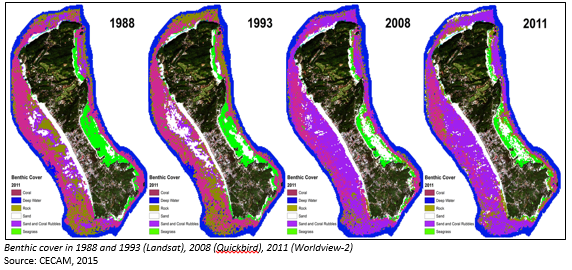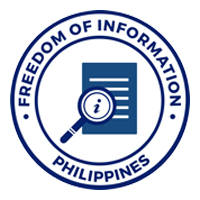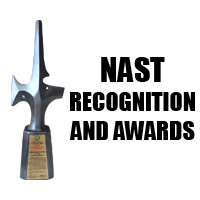
The National Academy of Science and Technology, Philippines (NAST PHL), through its Biological Sciences Division, Health Sciences Division, and Engineering Sciences and Technology Division, held the POLICY FORUM ON REHABILITATION OF BORACAY ISLAND AND MANAGEMENT OF COASTAL ENVIRONMENT PROBLEMS / CONCERNS on April 23, 2018 at Hotel Jen Manila, Roxas Boulevard, Pasay City. The policy forum was conducted to assist in the determination of appropriate rehabilitation road map specific to the current conditions and needs of Boracay Island Coastal Environment and help in the efforts towards the sustainable development and resiliency of Boracay Island Ecosystem after these initial steps towards its rehabilitation.
Highlighting the need to understand further the status of Boracay Island that necessitated its temporary closure for rehabilitation, Academician William G. Padolina welcomed the participants from NAST, different government agencies, research institutions and speakers who have done work in Boracay Island. Academician Rhodora V. Azanza, the focal person of the activity and chair of NAST PHL Biological Sciences Division, explained objectives of the policy forum, and emphasized that the forum also aims to elucidate the science behind the temporary closure of Boracay Island.
Academician Guillermo Q. Tabios III of the NAST PHL Engineering Sciences and Technology Division talked about Boracay Island: State of Land Resources and Land-Sea-Human Interactions. He discussed the role of coral reef ecosystem, one of the most important tourist attractions in Boracay. Citing previous and recent work of marine scientists, he emphasized that coral reef ecosystem contributes not only as one of the important tourism resources but also to white beach preservation by providing sediment supply and protection from the rough waves. Academician
Virginia C. Cuevas of the NAST PHL Biological Sciences Division discussed the state of water quality and microbiology of coastal waters in Boracay Island citing a study conducted in 2012. The parameters that were analyzed are the following: Nitrogen (nitrate), Phosphorus (orthophosphate), pH, Biochemical Oxygen Demand (BOD), Dissolved Oxygen (DO), Total Suspended Solids (TSS), water temperature, E. coli and Total Coliform count. It was reported that Mangrove Swamp 6 was slightly higher in pH and much higher BOD than Mangrove Swamp 1, Puka Beach, and Long Beach. Lugotan Cove had the highest E. coli and total coliform populations while the rest of the sites had the same levels. Good water quality was recorded in the coastal areas where commercial establishments are connected to the sewage system. For policy considerations, she recommended establishing a state-of-the-art waste water treatment facility at the outfall of drainage canals from informal settlers, wet market, parlors, shops, and other establishments before discharging into the coastal water. She emphasized the need to monitor the neighboring islands for waste water from houses, commercial establishments and sewage effluent disposal.
Dr. Ma. Lourdes San Diego-Mcglone, professor at the UP Marine Science Institute, discussed the coastal habitat degradation and decreasing coral cover in Boracay. She identified several environmental issues in Boracay Island, such as coastal erosion, improper coastal infrastructure development, high rate of population increase, water quality degradation, green tides, loss of coastal habitats, and lack of the local government’s knowledge on how to address the issues.
One of their research team findings that Mcglone presented is the island’s benthic cover, which showed that in a span of 23 years, coral cover decreased by 70% from 1988 to 2011. The most significant decrease occurred in 2008-2011 when tourist arrivals increased by 38.4%. Prior to this occurrence, a dramatic increase in sand and coral rubbles were also reported in SW Boracay during the years 2003-2006.
Another issue that the island is facing is the erosion of white beach. McGlone said that the deterioration of the reef ecosystem in front of the beach leads to erosion due to reduction of reef’s function as natural breakwater and supplier of white sand/beach sediments. The deterioration is caused by water quality degradation and direct impacts of marine leisure activities such as anchoring, diving, and snorkeling, to name a few.
She also cited improper construction of sea walls, restaurants and hotels on the backshore as secondary cause of erosion in the island and gave suggestions on how the management of the coastal environment could help preserve the white sand and other natural features of Boracay.
Dr. Vincent V. Hilomen, project manager of Smart SEA Project of the Department of Environment and Natural Resources (DENR), explained the current conditions of reefs in Boracay. Based on the reef condition from the live coral cover obtained from scuba diving in 2013, Balusbos and Motag are under poor condition, while Balinghai marine protected area (MPA), Friday’s Rock MPA, Lobster Rock and Caticlan are in fair condition. On the other hand, Coral Garden MPA is in good condition and the only excellent area out of the 8 sites surveyed in Boracay is Angol Point.In terms of the situation of the reef fishes in Boracay, none of the areas show very high fish biomass (40 MT/km2 and above). Balusbos and Motag show very low fish biomass (>10 MT/km2), while Balinghai, Coral Garden and Caticlan are under the medium range (>20 MT/km2). On the other hand, Fridays, Lobster and Angol Point are reported to be in high category (>30 MT/km2). Hilomen stressed the importance of wetlands ecosystem that serve as water catchment basin during rainy season. This prevents flooding and allow slow release of filtered water to the sea. He suggested rehabilitating habitats, harnessing locals for conservation activities, educating tourists and residents l, and imposing a policy of “no collection” of shells and other materials on the island.
Dr. Franklin C. Diza, chief of the Environmental Health Office in Department of Health, talked about public health and sanitation in Boracay. According to him, human feces is the most common source of microbial pathogens. Germs are passed on from an infected person to a new host through contaminated food, fingers, fluids, fields, and flies. Solid and waste water sanitation systems are the primary barriers that break the transmission route of pathogens specially the effective process of confining and treating feces. Diza said that there is a need to conduct risk assessment and management in the island as well as drinking-water quality surveillance and testing. Sanitation and capacity building, including advocacy and promotion campaign need logistical support to ensure the safety of the population against water contamination and water-borne diseases.
Lastly, Atty. Ana Mae P. Pedregosa, under the Department of Interior and Local Government's (DILG) Legal and Legislative Liaison Service and secretariat of Boracay Investigating Team (BIT), discussed role of the local government unit. She stated that the creation of the BIT is to exercise DILG’s supervisory power over local government units on environmental problems in Boracay and to establish the possible accountability of the local government and national government officials. She mentioned that on the DILG part, they would strengthen the monitoring performance and evaluation on the local government units to ensure that the Boracay crisis does not happen again.
Academician Eufemio T. Rasco Jr., chair of NAST PHL Agricultural Sciences Division gave the synthesis of the policy forum. The environmental problems in Boracay could be traced primarily to weak governance. The necessary laws and policies seem to be in place but the local and national government offices have long been short in implementing them. Two categories of possible solutions to the environmental problems of Boracay were suggested. For the short term rehabilitation, i.e during the 6 month closure, the sewage treatment facilities should be targeted to improve the quality of ground water and coastal water and thus help in the conservation of its marine ecosystem. Governance should be given importance, because the local government has a big role in the short and long term rehabilitation of the island. For planning purposes, the rehabilitation coverage, the impact on Boracay of the environmental and natural resource management of the neighboring islands, should be considered.
The speakers and participants agreed that in the short term, intensive assessment of the current status and strategic planning to address all issues and concerns should be prioritized. The major long term concerns include habitat degradation/conservation of coral reefs and maintenance of good water quality and good governance. The short and long term strategic activities should include among others strict implementation of laws and regulations, continuous monitoring, and capacity building of the community. In order to level expectations, there is a need to define what needs to be done within the six-month period aside from improving the sewage system, the elimination of illegal coastal structures and road building. The latest technology for sewage handling and wastewater treatment must be adopted in order not to aggravate the environmental problems. Finally the carrying capacity of the island (estimated by an earlier study) must be updated using present conditions in order to regulate effectively the number of persons and the timing and extent of the activities in the island.
Acd. Jaime C. Montoya, chair of the NAST PHL Health Sciences Division and executive director of the Philippine Council for Health Research and Development, Department of Science and Technology, gave the Closing Remarks. He stated that, everything that was discussed will be dependent on how people come up with a common objective. He noted that, there is a huge possibility that what happened to Boracay can happen to any of the islands in the country so this must be viewed as crisis situation and should be addressed by appropriate agencies working together under a common mandate and leadership.











